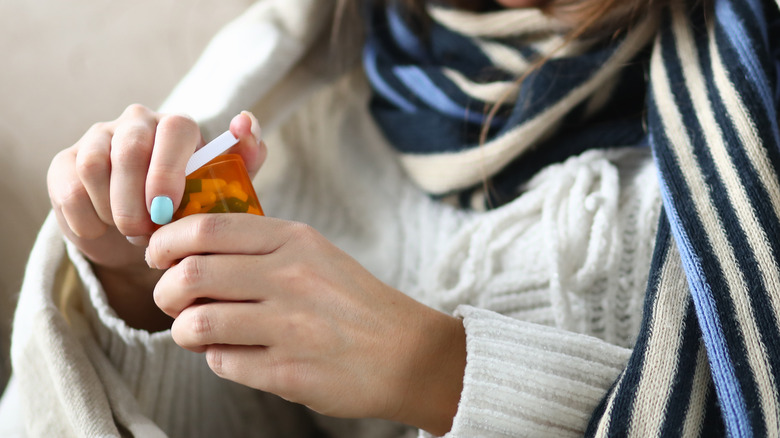This Time-Saving Trick Makes Opening Stubborn Medicine Bottles A Breeze
Tricky pickle jars, snug bottle caps, and stubborn prescription containers can leave our hands red and raw when those caps just won't budge. Perhaps you've heard the tip about running a stuck lid under a stream of hot water to help loosen it up. However, there's an even quicker hack for opening medicine bottles that can spare our hands a great deal of pain each time we reach into our medicine cabinet.
First off, if you're someone who struggles to unscrew your prescription pill bottles, you're not alone. Those small, child-proof caps are designed to be tricky to open in order to protect against children accidentally ingesting potentially harmful medications. Older adults can struggle with opening medicine bottles, in particular. In a 2005 study published in Pharmacy World & Science, researchers looked at Swedish adults ages 81 and older and assessed their ability to open different types of medication packaging and what factors were causing them difficulty. Over 30% of participants struggled to open pill bottles with a snap lid, while 14% were unable to open bottles with a screw cap. Adults who were older, resided in a facility, or had various health conditions (such as arthritis, Parkinson's disease, cognitive impairment, or vision issues) were less likely to be able to open their medication bottles.
Replace the cap upside down
This time-saving trick can be used by anyone, not just older adults. However, it does involve having to pry open that bottle cap one way or another first. Afterwards, you can eliminate this frustrating step in the future. Once you've popped the top off your prescription bottle and taken your medicine, flip the cap over and push it back down into the bottle, reports Inside Edition. You can think of it almost like a wine bottle stopper. You'll notice that for some prescription medication bottles, the top portion of the cap is smaller than the base and rounded with ridges. When turned upside down, it's these grooves that allow the cap to fit snuggly back into the bottle.
Healthcare company Kaiser Permanente implemented this non-childproof opening option for some of their own medication bottles, as reported via CBS News in 2017. The company explained that mailed prescriptions will arrive with the bottle cap in standard child-proof mode to protect against accidental consumption by young children, as well as to prevent the bottles from opening while in transit. Instructions come with patient medications explaining how to position the cap in non-childproof mode. Upon flipping the cap over, patients will see a warning label printed on the underside of the top. When placed back inside the bottle, this will turn the cap into a twist-off top rather than a push-and-turn top for easier future access.
Ask your pharmacy about alternate forms of medication packaging
Although this method can save us a lot of time and grief, it may increase the risk of potential accidents. The Centers for Disease Control and Prevention report that approximately 35,000 child hospitalizations occur annually due to children accidentally accessing medications. Keeping prescription bottle caps in their safety-locked position can reduce the risk of such emergencies, as well as keeping medications stored safely out of a child's grasp.
However, this doesn't mean that we have no choice but to struggle every time we go to open our medicine bottles. Rather, try reaching out to your local pharmacy for alternate packaging options. Some pharmacists will instead prepare your medications in a dosette (a plastic container sectioned off for each day of the week) or a blister pack (via PharmaSave). According to the previously mentioned 2005 study, only 10% of older adults were incapable of opening a blister pack, making it the type of medication packaging that the least number of participants struggled with in comparison to screw caps and snap lids. At the end of the day, if you decide to go with the upside-down cap hack, just remember to keep your medications safe and secure for everyone in your household.



